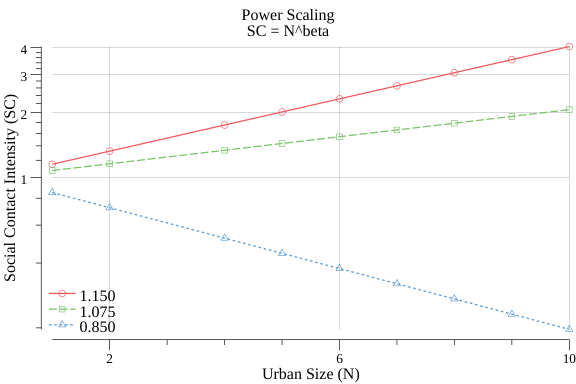Scaling Laws
“Scaling laws are power-law relationships of the form $Y = cX^β$, where $Y$ represents a variable which varies in a systematic way with the size $X$ of subsystems and $c$ and $β$ are parameters. They have two powerful advantages: they summarize structural features of systems in a very efficient way, and they reveal the effect of universal constraints acting on the structure and development over several orders of magnitude in these systems… The main resources enabling urban development are the technical and cultural innovations which increase the productivity, the diversity and the cohesion of human activities; the availability of these resources relies on the production and exchanges of information … The role of cities as centers for the integration of human capital and as incubators of invention was rediscovered by the “new” economic growth theory, which posits that knowledge spillovers among individuals and firms are the necessary underpinnings of growth (Lucas 1988, Romer 1986) … This seemingly spontaneous process, whereby knowledge produces growth and growth attracts knowledge, is the engine by which urban centers sustain their development through unfolding innovation. The essential role of knowledge generation, recombination and circulation within and across urban areas must be at the core of any proposed explanation for urban scaling.” (Pumain 2006)
Scaling Math
Urban Scaling Research finds that Social Contact Intensity is linked to City Size approximately as a power law:
$k(N) = k_{0} N^β$
with β = 1 + δ and δ ≈ 1/6 acording to Bettencourt.

Fig 2. Power Law of Urban Scaling
Fig 2 illustrates the power of scaling. The red line has δ = 0.15 and the green half of this, δ = 0.075. Both are cases of positive or superlinear scaling. For comparion δ can also be negative (sublinear), i.e.larger cities have smaller effects, as illustrated on the figure with δ = 0.85 (blue line).
A scaling factor of δ = 0.15 is fairly strong: An urban area with 5 times the population - 1 million people compared to another with 200.000 people - has the double Social Contact Intensity. 10 times the population (2 million people) gives 4 times the intensity.
‘Social Contact Intensity’ - as we use it here - is an umbrella term. Many aspects of social and economic activity within urban areas will follow such power laws. Many empirical studies find power laws with β around 1.1 - 1.2 as a general charcteristic. As Bettencourt puts it: ‘Cities primary function is open-ended social reactors… [which] exist in similar, but changing forms over a huge range of scales… [and] evolve acording to a small set of principles that operate locally… [so that] the average social, spatial, and infrastructural properties of cities… [follow] scaling relations that apply to all urban systems.’ .
Links:
Bettencourt (2013) Origins of Scaling in Cities pdf
Keuschnigg (2019) Scaling Trjectories of Cities pdf
Lucas (1988) On the Mechanics of Economic Development pdf
Pumain (2006) Evolutionary Theory of Urban Scaling pdf
Romer (1986) Increasing Returns and Long-Run Growth pdf
Schläpfer (2014) Scaling of Human Interactions with City Size pdf
Stier (2020) COVID-19 attack rate increases with citysize pdf